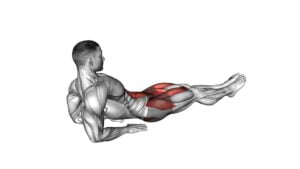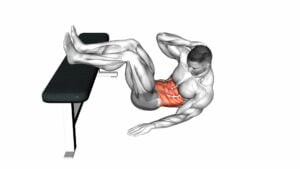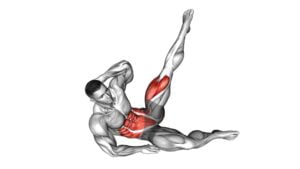Knee Tuck Oblique Crunch – Video Exercise Guide & Tips

Looking to sculpt and strengthen your obliques? Look no further than the knee tuck oblique crunch. This exercise targets those side muscles, helping you achieve a toned and defined waistline.
Watch This Exercise Video
In this video exercise guide, we'll show you the proper form and technique, common mistakes to avoid, and variations to keep things challenging.
Maximize your workout and get the results you desire.
Let's get started!
Key Takeaways
- The knee tuck oblique crunch targets oblique muscles for a toned and defined waistline.
- Proper form and technique are important to engage core muscles and prevent injury.
- Variations and modifications, such as adding weights or using different equipment, can increase intensity and engage more muscles.
- It is essential to focus on proper form, gradually increase intensity, and listen to your body to prevent injury and achieve desired results.
Benefits of the Knee Tuck Oblique Crunch
You will experience numerous benefits from incorporating the Knee Tuck Oblique Crunch into your workout routine. This exercise targets the oblique muscles, which are located on the sides of your abdomen. Strengthening these muscles is important for overall core stability and functionality. The Knee Tuck Oblique Crunch also offers variations to keep your workout challenging and engaging.
By performing the Knee Tuck Oblique Crunch, you won't only tone and strengthen your oblique muscles but also improve your balance and stability. This exercise helps to enhance your core strength, which is vital for maintaining proper posture and preventing lower back pain. Additionally, strong oblique muscles can improve your athletic performance by allowing you to generate more power and stability in rotational movements.
To add variety to your routine, you can try different variations of the Knee Tuck Oblique Crunch. For example, you can perform the exercise with a twist, where you bring your opposite elbow towards the opposite knee. This variation adds an extra challenge to your oblique muscles and increases the intensity of the exercise.
Now that you understand the benefits of the Knee Tuck Oblique Crunch, let's move on to the next section, which will focus on the proper form and technique to maximize your results.
Proper Form and Technique
To perform the Knee Tuck Oblique Crunch correctly, maintain proper form and technique throughout the exercise. This won't only maximize the benefits of the exercise but also minimize the risk of injury. Here are some important tips to help you maintain proper form:
- Start by lying on your back with your knees bent and feet flat on the ground.
- Place your hands behind your head, keeping your elbows wide open.
- As you crunch up, focus on bringing your right elbow towards your left knee while simultaneously bringing your right knee towards your left elbow.
- Engage your core muscles and avoid pulling on your neck or using momentum to lift yourself up. The movement should come from your obliques.
- Exhale as you crunch up and inhale as you lower back down to the starting position.
Common mistakes to avoid include:
- Using your neck muscles to lift your head instead of engaging your core.
- Rushing through the exercise and sacrificing proper form for speed.
- Not fully engaging your obliques and relying on other muscles to do the work.
Common Mistakes to Avoid
To ensure proper form during the knee tuck oblique crunch, it's important to pay attention to a few key points.
First, make sure to keep your core engaged and your back straight throughout the exercise to avoid straining your lower back.
Additionally, be mindful of your breathing, exhaling as you crunch and inhaling as you return to the starting position.
Lastly, avoid using momentum or swinging your legs to perform the movement, as this can compromise the effectiveness of the exercise and increase the risk of injury.
Proper Form Demonstration
Demonstrate proper form for the knee tuck oblique crunch exercise by consistently engaging your core muscles throughout the movement. This exercise provides numerous benefits, including strengthening your core, improving stability and balance, and targeting your oblique muscles.
To perform the knee tuck oblique crunch correctly, follow these tips:
- Start by lying on your back with your knees bent and feet flat on the floor.
- Place your hands behind your head, elbows wide.
- As you lift your upper body off the ground, twist your torso and bring your right elbow towards your left knee, while simultaneously tucking your right knee towards your chest.
- Repeat on the other side, bringing your left elbow towards your right knee.
- Remember to engage your core throughout the exercise to maximize its effectiveness.
Injury Prevention Techniques
To prevent injuries and avoid common mistakes, you should focus on maintaining proper form and engaging your core throughout the knee tuck oblique crunch exercise.
However, injury prevention starts even before you begin the exercise. It's important to warm up your body with some light cardio exercises such as jogging or jumping jacks. This will increase blood flow to your muscles and prepare them for the workout.
Additionally, incorporating stretching techniques into your warm-up routine can help improve flexibility and reduce the risk of injuries. Stretching the muscles involved in the knee tuck oblique crunch, such as the obliques and hip flexors, will help ensure that they're properly warmed up and ready for the exercise.
Variations and Modifications
For different ways to challenge yourself and target different areas of your obliques, try these variations and modifications of the Knee Tuck Oblique Crunch.
- Advanced Modifications:
If you're looking to take your workout to the next level, here are a few advanced modifications you can try:
- Weighted Knee Tuck Oblique Crunch:
Hold a dumbbell or kettlebell in your hands while performing the exercise to add resistance and increase the intensity.
- Medicine Ball Knee Tuck Oblique Crunch:
Hold a medicine ball between your feet as you perform the knee tuck oblique crunch to engage your core and obliques even more.
- Bosu Ball Knee Tuck Oblique Crunch:
Place a Bosu ball flat side down and balance on it while performing the exercise. This will challenge your stability and engage more muscles in your core.
By incorporating these variations and modifications into your workout routine, you can challenge yourself in different ways and target specific areas of your obliques.
Remember to start with the basic knee tuck oblique crunch and gradually progress to the advanced modifications for optimal results.
- Equipment Options:
If you don't have access to any equipment, don't worry! You can still modify the knee tuck oblique crunch without any additional tools. Here are a couple of equipment-free variations:
- Side Plank Knee Tuck Oblique Crunch:
Start in a side plank position and bring your top knee towards your top elbow, engaging your obliques as you crunch.
- Standing Knee Tuck Oblique Crunch:
Stand with your feet hip-width apart and bring one knee towards the opposite elbow, engaging your obliques as you crunch.
Tips to Maximize Your Workout
To get the most out of your workout, focus on proper form and engage your core throughout the knee tuck oblique crunch. This exercise targets your oblique muscles, helping to strengthen and define your waistline.
To increase the intensity of this exercise, you can add weight by holding a dumbbell or medicine ball while performing the movement. This will challenge your core and increase the resistance on your obliques. Another way to increase intensity is to slow down the movement, focusing on the contraction of your oblique muscles as you bring your knees towards your chest. This will make the exercise more challenging and effective.
Breathing is also an important aspect to consider during the knee tuck oblique crunch. Exhale as you contract your obliques and bring your knees towards your chest, and inhale as you return to the starting position. This helps to engage your core muscles and maintain control throughout the exercise. Remember to keep your breathing steady and controlled throughout the entire movement.
Safety Precautions and Considerations
Make sure to prioritize proper form and take necessary safety precautions while performing the knee tuck oblique crunch exercise. This will help you avoid injuries and maximize the effectiveness of the workout. Here are some safety precautions and considerations to keep in mind:
- Warm up exercises: Before starting the knee tuck oblique crunch, it's important to warm up your body. This can include light cardio exercises like jogging or jumping jacks, as well as dynamic stretches to loosen up your muscles.
- Equipment recommendations: While the knee tuck oblique crunch can be performed without any equipment, using a mat or an exercise ball can provide extra support and cushioning for your lower back. Make sure the equipment is stable and secure before starting the exercise.
- Listen to your body: Pay attention to any discomfort or pain during the exercise. If you experience any sharp or intense pain, stop immediately and consult with a healthcare professional. It's important to listen to your body and modify or adjust the exercise as needed to prevent injury.
Frequently Asked Questions
How Long Should I Hold the Contraction at the Top of the Knee Tuck Oblique Crunch?
When doing the knee tuck oblique crunch, it's important to focus on proper form.
To get the most out of this exercise, you should hold the contraction at the top for a few seconds. This will engage your oblique muscles and help you build strength and stability in your core.
Remember to keep your abs engaged and breathe throughout the movement.
Proper form is key to getting the best results from the knee tuck oblique crunch.
Can I Perform the Knee Tuck Oblique Crunch on a Stability Ball for Added Difficulty?
Yes, you can definitely perform the knee tuck oblique crunch on a stability ball for added difficulty. Using a stability ball will challenge your core stability and engage more muscles. It's a great modification if you want to take the exercise to the next level.
However, if you don't have a stability ball, there are alternative exercises you can try to target your obliques and core effectively.
Is It Necessary to Use a Mat or Can I Perform This Exercise on a Hard Surface?
When doing the Knee Tuck Oblique Crunch, you might wonder if you need to use a mat or if a hard surface will do.
It's not necessary to use a mat, but it can provide some benefits. A mat offers cushioning and support, which can be helpful if you have sensitive knees or a hard floor.
However, performing the exercise on a hard surface can increase the challenge and engage your core even more.
It's up to you and your preferences.
How Often Should I Include the Knee Tuck Oblique Crunch in My Workout Routine for Optimal Results?
For optimal results, it's important to consider how often you include the knee tuck oblique crunch in your workout routine. The frequency of this exercise will depend on your fitness goals and overall workout plan.
It's recommended to include it 2-3 times per week for a duration of 10-15 minutes. If you want to intensify the exercise, you can try the stability ball modification.
Remember to always listen to your body and adjust accordingly.
Can I Perform the Knee Tuck Oblique Crunch if I Have a History of Lower Back Pain?
If you have a history of lower back pain, it's important to be cautious when performing the knee tuck oblique crunch. This exercise puts strain on the lower back, which could exacerbate your pain.
Instead, consider modifying the knee tuck by keeping your feet on the ground and focusing on the oblique crunch.
There are also alternative exercises that target the obliques without putting as much pressure on the lower back.
Conclusion
In conclusion, the knee tuck oblique crunch is a highly beneficial exercise for targeting the oblique muscles and improving core strength.
By focusing on proper form and technique, avoiding common mistakes, and incorporating variations and modifications, you can maximize the effectiveness of this exercise.
It's important to prioritize safety and consider any necessary precautions before attempting this exercise.
With these tips in mind, you can enhance your workout and achieve your fitness goals.

Author
Years ago, the spark of my life’s passion ignited in my mind the moment I stepped into the local gym for the first time. The inaugural bead of perspiration, the initial endeavor, the very first surge of endorphins, and a sense of pride that washed over me post-workout marked the beginning of my deep-seated interest in strength sports, fitness, and sports nutrition. This very curiosity blossomed rapidly into a profound fascination, propelling me to earn a Master’s degree in Physical Education from the Academy of Physical Education in Krakow, followed by a Sports Manager diploma from the Jagiellonian University. My journey of growth led me to gain more specialized qualifications, such as being a certified personal trainer with a focus on sports dietetics, a lifeguard, and an instructor for wellness and corrective gymnastics. Theoretical knowledge paired seamlessly with practical experience, reinforcing my belief that the transformation of individuals under my guidance was also a reflection of my personal growth. This belief holds true even today. Each day, I strive to push the boundaries and explore new realms. These realms gently elevate me to greater heights. The unique combination of passion for my field and the continuous quest for growth fuels my drive to break new ground.







